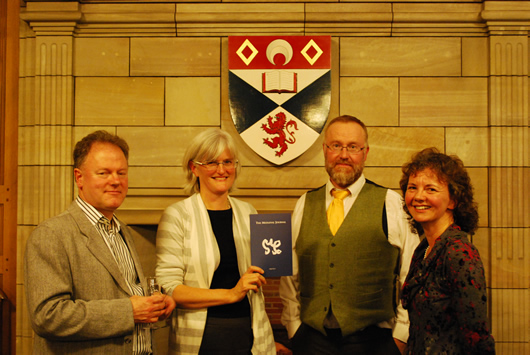Inscription from Staffordshire Hoard provides insight on Anglo-Saxon Christianity

Ian Johnson (General Editor), Frances Andrews (Member of Editorial Board & Founding Director of SAIMS), Alex Woolf (Member of Editorial Board & Current Director of SAIMS), Margaret Connolly (General Editor).
A rare inscription on a strip of gold, found as part of the Staffordshire Hoard, is from the Bible, new research has discovered.
In the first issue of The Mediaeval Journal, published by the University of St Andrews, Elisabeth Okasha, Professor Emerita and Acting Director of the Language Centre at the University College Cork, Ireland, suggests the quotation may demonstrate religion was carried out by the people and not dominated by church leaders.
Although there are many religious inscriptions on the 250 Anglo-Saxon objects which have already been discovered, just 16 are accurate biblical quotations. And just two, before the Staffordshire strip, are from the Old Testament.
The preference for quotations from the New Testament, Psalms and paraphrased passages, indicates that the inscriptions may have been made by those taking part in religious ceremonies rather than church leaders.
Professor Okasha says: “Some interesting questions remain, probably the most striking being, why do so few Anglo-Saxon inscriptions contain a biblical text?
“The paucity of biblical quotation in the inscriptions seems particularly surprising in view of the involvement of the Anglo-Saxon church in literacy and learning, especially in Latin learning, and in the translation of at least some parts of the bible from Latin into Old English.
“Could it be that the influence of the church was concentrated more, or perhaps experienced by lay people more, in the liturgical rather than in the strictly biblical side of church teaching?”
The new international scholarly journal, The Mediaeval Journal, is based in the university’s Institute of Mediaeval Studies and published in partnership with leading European academic press, Brepols.
It is run by General Editors Dr Margaret Connolly and Dr Ian Johnson of the School of English and Dr James Palmer of the School of History.
The first issue also includes an article by Professor Tony Hunt, a former member of the French Department in St Andrews, recently retired from Oxford University.
Its aim is to be a cross-disciplinary journal.
Ian Johnson, General Editor, said: “The Mediaeval Journal is in the powerful position of being able to draw on an Editorial Board of over thirty specialists from within St Andrews and across the globe.
“Mediaeval Studies, in which St Andrews is an undisputed world leader, is a large, vibrant, and fast-growing field –in both research and teaching.
“But whereas contemporary mediaevalists are of necessity interdisciplinary, the journals available to them are, with too few exceptions, generally restricted to single disciplines, such as History, Art History, or Languages.
“Addressing this, The Mediaeval Journal (TMJ) will, as a European-based but inclusively international journal, bring the latest contributions together in the lingua franca of English, and publish (both online and in print) peer-reviewed articles, essays, studies, debates and editions from specialists in all areas of Mediaeval Studies. It will also provide a reviews service that is unusually fast, fair, and constructive.”
Note to editors
The Staffordshire hoard of Anglo-Saxon treasure was discovered in the English county in July 2009.
The hoard of more than three thousand objects, from jewelled sword hilts to crosses, buckles and helmet fragments also contained several garnet-inlaid gold strips including one with an inscription.
Issued by the Press Office, University of St Andrews
Contact Fiona MacLeod on 01334 462108/ 0771 414 0559.
Ref: (medieval 14/12/11)
Category Research